- Home
- Mark Frost
The Secret History of Twin Peaks
The Secret History of Twin Peaks Read online
Start Reading
Table of Contents
Copyright Page
Thank you for buying this
Flatiron Books ebook.
To receive special offers, bonus content,
and info on new releases and other great reads,
sign up for our newsletters.
Or visit us online at
us.macmillan.com/newslettersignup
For email updates on the author, click here.
The author and publisher have provided this e-book to you for your personal use only. You may not make this e-book publicly available in any way. Copyright infringement is against the law. If you believe the copy of this e-book you are reading infringes on the author’s copyright, please notify the publisher at: http://us.macmillanusa.com/piracy.
THE SECRET HISTORY of TWIN PEAKS
FEDERAL BUREAU OF INVESTIGATION
Philadelphia, Pennsylvania
Office of the Deputy Director
INTEROFFICE MEMORANDUM
DATE: 8-4-2016
FROM: GORDON COLE, Deputy Director
TO: , Special Agent
Dear Agent
The accompanying material is confidential and approved for your eyes only.
The enclosed dossier was recovered on 7-17-2016 from a crime scene that is still under active investigation. All details of this situation are classified three levels above top secret.
It is being given to you for comprehensive analysis, cataloging and cross-referencing content against all known databases under Code Red measures. We need to learn and verify the person or persons responsible for compiling this dossier and we need to know it yesterday!
Background: The content of the dossier appears to have some relationship to an investigation conducted in northwest Washington State many moons ago by Special Agent Dale Cooper, who worked under my command at that time.
The case involved a series of homicides in and around a small town called Twin Peaks, most notably the murder of a young woman named Laura Palmer. That case is considered closed but aspects of it may be relevant to your work, so we are also granting you access to all of Agent Cooper’s files and tapes.
Also attached is a document highlighting previous processing of the dossier by Bureau personnel.
Roll up your sleeves and get to work on this thing—time is of the essence—and get back to me with your findings ASAP.
Sincerely Yours,
Deputy Director Gordon Cole
P.S. When you get done with this come see me immediately. By then I may have more for you to do.
FEDERAL BUREAU OF INVESTIGATION
Philadelphia, Pennsylvania CLASSIFIED
DATE:
8/4/2016 TOPIC:
DOSSIER PROCESSING TIMELINE SUBMITTED BY:
COLE, GORDON
SYNOPSIS OF FACTS:
The following dossier was recovered on .
Time and location noted, but are classified as strictly NEED TO KNOW.
Field Agents and discovered dossier while on assignment in . It was recovered from a crime scene that is still classified as unsolved and may have relevance to a previous crime or crimes in 1991 that is similarly classified.
Dossier was submitted to DIRECTOR on 7-17-2016.
Dossier referred by DIRECTOR to Investigations and Operations Support Section (IOSS) on 7-20-2016.
Special Agent T P will begin analysis and report on validity. All work will be conducted and dossier will be kept in clean room at FBI HQ.
STATED PRIORITY: Identify person or persons who compiled dossier.
CONFIRMED: Special Agent TP has completed all required background checks, and filed completed forms SF-86 and FD-258.
CONFIRMED: Special Agent TP adjudicated for Top Secret security clearance as of 2009 and approved for adjunct liaison with Special Task Force B and all related files, per Crypto Clearance 12.
CONFIRMED: Special Agent TP will report exclusively to head of Special Task Force B and to DIRECTOR.
CONFIRMED: Special Agent TP begins first analysis on 8-5-16.
All comments and annotations will be included and initialed.
FEDERAL BUREAU OF INVESTIGATION
Philadelphia, Pennsylvania
ANALYST’S INTRODUCTORY REMARKS:
The following constitute my thoughts after a cursory examination of the dossier and ahead of beginning the work at hand:
Means, methodology and motivation for compilation of these documents and ephemera will be commented upon throughout and initialed (TP) as separate entries in the margins. All content is presented here in the order in which it appears in the original dossier, without revision. This order of the documents, as far as can be ascertained at first glance, appears to be chronological and as a result presents a direct, if intermittent, sense of historical narrative. As to what this narrative conveys, as stated I will present my comments throughout.
The author or authors self-identifies in the body of the MS as “The Archivist.” Given the scope of the dossier and the way in which the Archivist organized it, I will attempt to offer summaries within the body of the work as I proceed.
The dossier was discovered inside a carbon steel lockbox, 17 × 11 × 3. Lockbox was not a standard size and does not appear to be of any known commercial manufacture. It also features a highly sophisticated triple locking mechanism that required extensive efforts to crack.
It is my considered opinion that this lockbox may have been personally fashioned by the person identified within as the Archivist.
The dossier itself fits snugly inside the margins of the box, further suggesting that the lockbox was custom made to accommodate it.
The dossier is contained and bound within a book-shaped ledger, which also appears to be of sophisticated self-manufacture. Its embossed cover is fashioned from boards encased in dark green cloth.
It appears well-worn, suggesting it had at some point been exposed to the elements. Nevertheless—fortunately—upon closer examination once opened, a fully sealed and vulcanized boxlike encasement around the top, bottom and fore edges kept the ledger’s contents entirely free from damage.
The only visible ornamentation on the entire ledger appears on the spine and is pictured at right.
Measuring less than one-half inch and apparently hand-tooled, it depicts a series of triangles, the purpose or meaning of which at first view remains unclear.
INSIDE THE LEDGER ITSELF
The documents presented inside appear to be excellent facsimiles of the originals. A few appear to be originals and, by virtue of their age, fragile, but all contents will be returned exactly as they originally appeared.
Each page is covered by a clear plastic membrane (.02 mil thick, measured by digital micrometer), which appears to be of standard manufacture, although the unusual size suggests the membranes were also custom fitted.
This membrane holds each document in place. No glues or tapes were used to affix the documents to the neutrally colored pages, which are all made from paper of the same, uniform thickness, similar to construction paper.
Closer examination of the edges of both the membranes and pages suggests they were cut by hand and not mass produced.
Most of the documents appear one to a page, leaving room above and below for annotations, presumably made by the Archivist. These appear regularly throughout the dossier.
The dossier appears to be divided into easily identified and sub-headed sections. They will be presented here in their original form and order. I intend to include my own comments in the margins. These will include fact checking, analysis and occasionally personal reactions or comments. Whenever possible, documents will be traced to their alleged original source and verified. Any instances of
documents that prove resistant to verification will be duly noted.
It is my intention that engaging with the contents in this manner will achieve the stated and desired outcome: determining the identity of the Archivist.
Sworn and notarized before me on this day, 8-28-16,
Special Agent T P
THE DOSSIER
*** OPENING STATEMENT:1
A wise man once told me that mystery is the most essential ingredient of life, for the following reason: mystery creates wonder, which leads to curiosity, which in turn provides the ground for our desire to understand who and what we truly are.
The search for meaning at the heart of life brings us to the contemplation of an eternal enigma. Mysteries are the stories we tell ourselves to contend with life’s resistance to our longing for answers. Mysteries abound. This continent, this country, our own earthly origins are all laden with them, underlying our existence, pre-dating all our childish notions of “history.” Mythology precedes our access to historical or scientific fact, and, we know now, fulfilled much the same function for earlier civilizations – providing meaning in the face of a remorseless, indifferent universe – but in the absence of scientifically verifiable fact it is necessary to sometimes view them as one and the same.
So it is best to start at the beginning.
So signed and duly sworn:
THE ARCHIVIST2
1 There is no title page, author page, table of contents, index or appendices anywhere in the ledger. Nothing except the frequent interstitial interpretative comments by “The Archivist” and the following opening statement, which functions as a kind of “foreword” before the first “section”–TP
2 This is the only handwritten portion of the dossier, and block printing is impossible to trace to an individual. The typed sections appear to be the product of the same manual typewriter, most likely a Corona Super G, a popular, lightweight portable model which was first manufactured in the 1970s.
The dossier then simply begins with the first series of documents–TP
*I* EXCERPT FROM THE EXPEDITION JOURNALS OF WILLIAM CLARK AND MERIWETHER LEWIS. SEPTEMBER 20, 1805
1
2
1 Confirmed that this is an actual entry from the well-known published journals. The paper and ink, applied it seems with a quill, appear appropriate to the period. This is either a remarkable facsimile of William Clark’s actual handwriting from his original journals–or the original itself. Have contacted the National Archives and am awaiting verification on that point–TP
2 This passage describes Clark’s first meeting with the tribe known later to us as the Nez Perce, or Pierced Noses, who were a significant presence in this part of the territory. This name was given them by early French trappers, after the tribe’s affinity for jewelry and other adornments affixed through the nose.
This encounter occurred soon after the expedition passed into the eastern reaches of what is now Washington State and not far south of the present-day location of Twin Peaks. The following day these same men led Clark to meet another chief whose camp was farther downriver. This chief was called Twisted Hair–TP
*2* EXCERPT FROM THE EXPEDITION JOURNALS OF WILLIAM CLARK AND MERIWETHER LEWIS. SEPTEMBER 21, 1805
1
1 I have now heard from an expert who positively verified this section as William Clark’s handwriting and a known part of the historically published journals; the two commanders of the expedition had indeed split their party to hunt for provisions a few days earlier—TP
*3* EXCERPT FROM A LETTER WRITTEN BY MERIWETHER LEWIS TO PRESIDENT THOMAS JEFFERSON. DATED SEPTEMBER 25, 1805.
1 2
1 This entire letter remains problematic. I can find no record of it in the original L & C journals or any mention of it among the voluminous correspondence penned by Lewis to President Jefferson.
Prior to the expedition Lewis had served as Jefferson’s secretary for two years, lived in the White House and during that time became one of his most trusted confidants. Jefferson’s father was a business associate of Lewis’s grandfather, and the president had known Lewis since he was a boy, growing up not far from Jefferson’s Virginia estate.
Because Lewis had experienced extensive contact with Native Americans during his youth, enjoyed cordial relations and often championed their cause, Jefferson personally chose Lewis to lead the Corps of Discovery. Lewis then selected as his co-commander his former commanding officer, the more experienced military man and explorer William Clark.
Jefferson’s selection of Lewis was kept secret, as was the expedition itself. The Louisiana Purchase had not yet been completed during these planning stages, and the Corps of Discovery would be heading into hostile territory that three European powers—the French, Spanish and English— had all targeted for their own expansionist colonial ambitions. The expedition would be fraught with danger from start to finish, security was paramount and time was of the essence.
Lewis’s cryptic reference to a private conversation with Jefferson bears deeper investigation. He does elaborate, somewhat, during the following passage—TP
2 On the face of it, it would seem this letter bears all the earmarks of an elaborate hoax … and yet, analysis does confirm this as the handwriting of Lewis to an almost certain probability. As this is one of the few “original” documents in the dossier, I have submitted it for independent carbon dating and chemical testing of both the paper and ink to see if it is in fact appropriate to the stated time frame of the early 19th century.
No mention is made of any side trip made by Lewis during this time frame in his published journals. However, the next entry in the official journals, authored by either Lewis or Clark, does not appear for six more days.
It has always been the opinion of Lewis scholars that this period of time was used for the construction of the canoes, and for rest and recovery, as many of the expedition had by this time fallen ill with intestinal disorders related to malaria—TP
*4* EXCERPT FROM A JOURNAL FOUND IN THE PRIVATE PAPERS OF PRESIDENT THOMAS JEFFERSON. UNDATED: LATE 1805 (?)1
2
3
ARCHIVIST’S NOTE
The principals of the Corps of Discovery returned to Washington in 1807, where Lewis and Clark were greeted as heroes. The vast collection of plant and animal specimens they brought back with them kept scientists engaged for years. Their celestial and geographical observations filled in the map of what would soon become the western United States. The expedition was judged a spectacular success.
As an immediate reward for his years of service, in 1807 Jefferson appointed Lewis as governor of the Upper Louisiana Territory, a position he returned to St. Louis to fill. Two troubling and difficult years followed.
Two sharply divergent narratives emerge from this period: either Lewis began a steep descent into alcoholism and incipient madness, or he became the target of an elaborate and effective plot by powerful enemies already entrenched in the developing Western territories to undermine his position.4
1 Let it be stated up front that there is no copy or record of this letter among the official presidential papers, but once again handwriting analysis and chemical testing of paper and ink suggest it is the work of Thomas Jefferson.
My attempt to track this letter led me to a cache of assorted and supposedly “lost” writings, a collection of unbound manuscripts discovered in the archives at Monticello in 1870 by the president’s oldest living son, Thomas Randolph Jefferson. This cache was transferred to the care of the State Department at around that time, in a box labeled “Private—Unexamined.”
I’ve accessed this collection—in the 1940s it was moved to a section of the Library of Congress that requires maximum security clearance—and was frankly astonished. Many of these writings have never been made public, as they contain the president’s musings on a number of strange, disparate and esoteric subjects, among them the role of Freemasonry in the lives of the founding fathers, the “real and present danger” to the young Repu
blic, and Masonry itself, of Adam Weishaupt’s Bavarian Illuminati—a perennial paranoid conspiracy bogeyman—and Jefferson’s fascination with supernatural elements of Native American mythology.
Jefferson and Lewis were both high-ranking Freemasons of long standing, members of a fraternal organization that emerged in the 15th century. Its original purpose seems to have been regulatory, setting qualifying professional standards for stonemasons while serving as an intermediary for them with clients or authorities, much like a modern guild or union. Over the centuries, Freemasonry evolved into a worldwide fraternal body and expanded its membership far beyond craftsmen into statecraft and even the foundation of governments, including America’s own, taking on an air of secrecy and even mysticism. Its closely guarded rituals and symbolism make it one of the longest-standing “secret societies” in known history.
While preparing for the expedition, at the direction of the president, Lewis had spent extensive time studying at the library of the American Philosophical Society in Philadelphia, founded by Benjamin Franklin—a high-ranking Mason himself. Lewis spent weeks there studying various physical sciences he would use on the expedition, and who knows what else. The Society at this time was rumored to also have collected the largest and most extensive library of ancient esoteric literature in North America, dating back centuries, on such occult subjects as alchemy and “transmutation.”
But in none of the aforementioned archives, either public or private, did I find any other copy of the entry shown here. Which leaves the intriguing possibility that the copy in this dossier may be a previously undiscovered original—TP

 Rogue
Rogue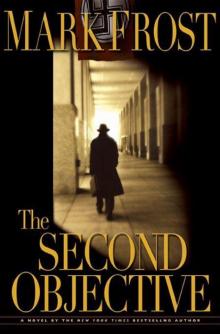 The Second Objective
The Second Objective Alliance
Alliance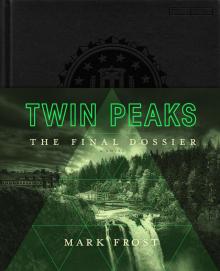 Twin Peaks: The Final Dossier
Twin Peaks: The Final Dossier The Paladin Prophecy
The Paladin Prophecy Game Six: Cincinnati, Boston, and the 1975 World Series: The Triumph of America's Pastime
Game Six: Cincinnati, Boston, and the 1975 World Series: The Triumph of America's Pastime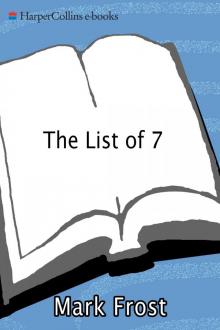 The List of Seven
The List of Seven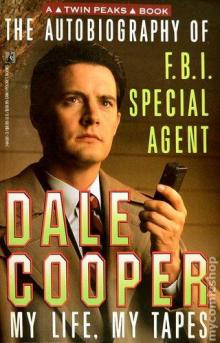 The Autobiography of FBI Special Agent Dale Cooper
The Autobiography of FBI Special Agent Dale Cooper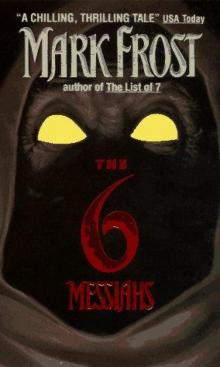 The Six Messiahs
The Six Messiahs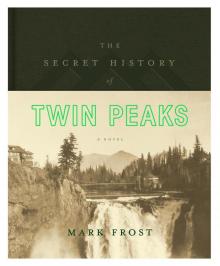 The Secret History of Twin Peaks
The Secret History of Twin Peaks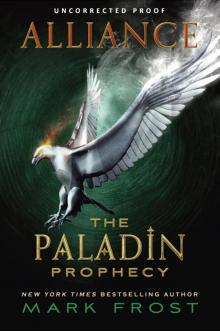 Paladin Prophecy 2: Alliance
Paladin Prophecy 2: Alliance Game Six
Game Six